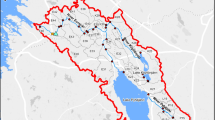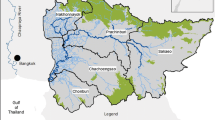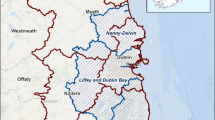Abstract
Due to poor urban sanitation farmers in and around most cities in developing countries face highly polluted surface water. While the sanitation challenge has obvious implications for environmental pollution and food safety it can also provide ‘free’ nutrients for irrigating farmers. To understand the related dimensions, a box-flow model was used to identify the most important water and nutrient flows for the Ghanaian city of Kumasi, a rapidly growing African city with significant irrigation in its direct vicinity. The analysis focused on nitrogen and phosphorus and was supplemented by a farm based nutrient balance assessment. Results show that the city constitutes a vast nutrient sink that releases considerable nutrients loads in its passing streams, contributing to the eutrophication of downstream waters. However, farmers have for various practical reasons little means and motivation in using this resource of nutrients. This might change under increasing fertilizer prices as the nutrient load will continue to increase by 40% till 2015 assuming a widening gap between population growth and investments in water supply on one side and investments in sanitation on the other. However, even a strong investment into flushing toilets would not reduce environmental pollution due to the dominance of on-site sanitation systems, but instead strongly increase water competition. Key options to reduce the nutrient load would be via optimized waste collection and investment in dry or low-flush toilets. The latter seems also appropriate for the city to meet the water and sanitation Millennium Development Goals (MDGs) without increasing water shortages in toilet connected households.



Similar content being viewed by others
References
Baccini P, Bader H-P (1996) Regionaler Stoffhaushalt, Erfassung, Bewertung und Steuerung. Spektrum Akademischer Verlag, Heidelberg
Bader H-P, Scheidegger R (1995) SIMBOX. Benutzeranleitung zum Programm SIMBOX. Eawag, Dübendorf
CEDAR (2002) Final technical report. R7330: peri-urban natural resources management at the watershed level, Kumasi, Ghana. Royal Holloway University of London
Cornish GA, Lawrence P (2001) Informal irrigation in peri-urban areas: a summary of findings and recommendations, DFID's Water KAR Project R7132, Report OD 144. HR Wallingford, Wallingford 54 pp
Cornish G, Mensah E, Ghesquire P (1999) Water quality and peri-urban irrigation: an assessment of surface water quality for irrigation and its implication for human health in the peri-urban zone of Kumasi, Ghana. Report OD/TN 95 September 1999. DFID’s Water KAR (Knowledge and Research) Project R7132, HR Wallingford, UK
Danso G, Drechsel P, Wiafe-Antwi T, Gyiele L (2006) Income generated by farming systems in and around Kumasi. In: van Veenhuizen R (ed) Cities farming for the future: urban agriculture for green and productive cities. RUAF Foundation, IDRC and IIRR. pp 205-207
Drechsel P, Abaidoo RC, Amoah P, Cofie OO (2000) Increasing use of poultry manure in and around Kumasi, Ghana: is farmers’ race consumers’ fate? Urban Agric Mag 2:25–27
Drechsel P, Kunze D (eds) (2001) Waste composting for urban and peri-urban agriculture—closing the rural-urban nutrient cycle in sub-Saharan Africa. IWMI/FAO/CABI, Wallingford 229 pages
Drechsel P, Giordano M, Gyiele L (2004) Valuing nutrients in soil and water: concepts and techniques with examples from IWMI studies in the developing world. Research Report 82. International Water Management Institute, Colombo, Sri Lanka. http://www.iwmi.cgiar.org/Publications/IWMI_Research_Reports/PDF/pub082/RR82.pdf
Drechsel P, Graefe S, Sonou M, Cofie OO (2006) Informal irrigation in urban West Africa: an overview. IWMI, Colombo. Research Report 102. http://www.iwmi.cgiar.org/Publications/IWMI_Research_Reports/PDF/pub102/RR102.pdf
Eawag (2007) Tracking material flows in foreign lands. Eawag News 62e. Swiss Federal Institute of Aquatic Science and Technology (Eawag), Zurich, Switzerland. (http://www.eawag.ch/services/publikationen/eanews/news_62/index_EN)
Erni M (2007) Modelling urban water flows: an insight into current and future water availability and pollution of a fast growing city. Case Study of Kumasi, Ghana. MSc thesis. Swiss Federal Institute of Technology (ETH), Zurich, Switzerland. (http://e-collection.ethbib.ethz.ch/ecol-pool/dipl/dipl_307.pdf; accessed on 23. July 2009)
Erni M, Bader HP, Scheidegger R, Drechsel P, Zurbrügg C, Kipfer R (2010) Urban water and nutrient flows in Kumasi, Ghana. Submitted to the Urban Water Journal
EEA (2003) Europe’s environment: the third assessment. Environmental assessment report No 10. European Environment Agency, Copenhagen, Denmark. (http://www.eea.europa.eu/publications/environmental_assessment_report_2003_10/kiev_chapt_08.pdf; accessed on 19. July 2007)
Færge J, Magid J, Penning de Vries FWT (2005) Urban nutrient balance for Bangkok. Ecol model 139:63–74
Gleick P (1996) Basic water requirements for human activities: meeting basic needs. Water Int 21(2):83–92
GSS (2002) 2000 population and housing census. Summary report of final results. Ghana Statistical Service, Accra, Ghana
GSS (2005) 2000 population and housing census. Ashanti Region. Analysis of district data and implications for planning. Ghana Statistical Service, Kumasi, Ghana
Gray S, Becker N (2002) Contaminant flows in urban residential water systems. Urban Water 4:331–346
GTZ (2007) MDG monitoring for urban water supply and sanitation; Catching up with reality in sub-Saharan Africa. GTZ, Eschborn
GWCL (2006) Yearly piped water production in Kumasi. Unpublished data, Ghana Water Company Limited, Regional Office, Kumasi, Ghana
Huang D, Bader H, Scheidegger R, Schertenleib R, Gujer W (2006) Confronting limitations: new solutions required for urban water management in Kunming City. J Environ Manag 84:49–61
Janssen BH, Boesveld H, Rodriguez MJ (2005) Some theoretical considerations on evaluating wastewater as a source of N, P and K for crops. Irrigat Drain 54(S1):S35–S47
Jeppson U, Hellstrom D (2002) System analysis for environmental assessment of urban water and wastewater systems. Water Sci Technol 46(6–7):121–129
Keraita B (2002) Wastewater use in urban and peri-urban agriculture in Kumasi, Ghana. MSc thesis, Wageningen University, The Netherlands
Kindness H (1999) Supply and demand for soil amelioration in peri-urban Kumasi. Kumasi Natural Resources Management Project (KNRP). Natural Resources Institute, Chatham
Langergraber G, Müllegger E (2005) Ecological sanitation—A way to solve global sanitation problems? Environ Int 31(3):433–444
Larsen TA, Guyer W (1996) Separate management of anthropogenic nutrient solutions (human urine). Water Sci Technol 34:87–94
Leitzinger C (2000) Ist eine Co-Kompostierung aus stofflicher Sicht in Kumasi/Ghana sinnvoll? MSc Thesis. ETH, Zurich, Switzerland
McGregor D, Simon D, Thompson D (2002) Peri-urban natural resources management at the watershed level: Kumasi, Ghana. Final Technical Report for DFID project R7330. CEDAR-IRNR, Royal Holloway University of London, London
Mensah A (2006) Characteristics of liquid and solid waste management in Kumasi. Personal communications and unpublished data. Waste Management Department, Kumsasi, Ghana
Montangero A, Belevi H (2007) Assessing nutrient flows in septic tanks by eliciting expert judgment: a promising method in the context of developing countries. Water Res 41:1052–1064
Montangero A, Cau LN, Anh NV, Tuan VD, Nga PT, Belevi H (2007) Optimising water and phosphorus management in the urban environmental sanitation system of Hanoi, Vietnam. Sci Total Environ. doi:10.1016/j.scitotenv.2007.05.032
MSD (2006) Climate data of Kumasi from 1961–2006. Meteorological Service Department, Kumasi
Obuobie E, Keraita B, Danso G, Amoah P, Cofie O, Sally LR, Drechsel P (2006) Irrigated urban vegetable production in Ghana: characteristics, benefits and risks. IWMI-RUAF-CPWF, Accra
Otterpohl R, Oldenburg M, Büttner S (1999) Alternative Entwässerungskonzepte zum Stoffstrommanagement. Korrespondenz Abwasser 46(2)
Qadir M, Wichelns D, Raschid-Sally L, Singh Minhas P, Drechsel P, Bahri A, McCornick P (2007) Agricultural use of marginal-quality water—opportunities and challenges. In: D. Molden (ed) Water for food, water for life. A comprehensive assessment of water management in agriculture, chapter 11. Earthscan and Colombo: International Water Management Institute, London, pp 425–457 http://www.iwmi.cgiar.org/assessment/Water%20for%20Food%20Water%20for%20Life/Chapters/Chapter%2011%20MQ%20Water.pdf
Raschid-Sally L, Jayakody P (2008) Drivers and characteristics of wastewater agriculture in developing countries: results from a global assessment. IWMI Research Report 127, International Water Management Institute Colombo, Sri Lanka
Sam A, Asare K (2007) Government secures funds to improve water in Ksi. Daily Graphics, Ghana
Scott CA, Zarazua JA, Levine G (2000) Urban wastewater reuse for crop production in the water-short Guanajuato river basin, Mexico. IWMI Research Report 41, Colombo
Simon D, Poku O, Gyabaah KN (2001) Survey of large industries in Kumasi: water use and environmental imp acts. CEDAR-IRNR Kumasi Paper 6, Royal Holloway University of London
Smaling EMA, Fresco LO (1993) A decision-support model for monitoring nutrient balances under agricultural land use (NUTMON). Geoderma 60:235–256
Vickers A (2001) Handbook of water use and conservation. WaterPlow, Amherst
WSMP Ghana (2009) Ghana can meet MDG target for drinking water, www.ghana.watsan.net/page/692
Acknowledgements
This article and the MSc. thesis on which it is based were supported and financed by Eawag, IWMI, the Swiss Federal Institute of Technology Zurich (ETH) and the Swiss National Center of Competence in Research North-South (NCCR North-South). Special thanks go to Bernard Keraita for the farm interview data, and Daan Van Rooijen and Richard Kuffor from IWMI for their valuable discussions and inputs. We also thank the various partners in Kumasi that contributed to the system analysis and data collection, particularly the Department of Civil Engineering of KNUST, the Kumasi Metropolitan Assembly and the Ghana Water Company Limited.
Author information
Authors and Affiliations
Corresponding author
Rights and permissions
About this article
Cite this article
Erni, M., Drechsel, P., Bader, HP. et al. Bad for the environment, good for the farmer? Urban sanitation and nutrient flows. Irrig Drainage Syst 24, 113–125 (2010). https://doi.org/10.1007/s10795-009-9083-9
Published:
Issue Date:
DOI: https://doi.org/10.1007/s10795-009-9083-9




